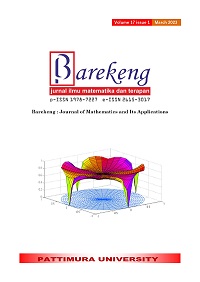REGIONS GROUPING IN CENTRAL SULAWESI PROVINCE BY TRANSMITTED DISEASE USING FUZZY GUSTAFSON KESSEL
Abstract
Health is one of the main indicators in determining the human development index. This is in contradiction with the situation in several areas in Indonesia where infectious diseases are the cause of death and have become extraordinary events. It was recorded in Central Sulawesi that in 2020 there were 8 extraordinary events due to infectious diseases which made this province become relatively high infectious diseases. One of the efforts that can be made to identify infectious diseases in an area is to form a grouping of locations into a group that has similarities and same characteristics. This is intended to provide information related to health in each region. Cluster analysis is one of method that can be used to grouping the data. Cluster analysis is the process of dividing data into a group based on the degree of similarity. Data with similar characteristics will be gathered in one group. One of the algorithms in cluster analysis is Fuzzy Gustafson Kessel which can produce relatively better groupings compared to the basic algorithms in cluster analysis. This study will use data on infectious diseases in Central Sulawesi Province with several recorded infectious diseases. From 13 regions, 5 clusters were formed. Clusters 1, 2 and 3 each consist of 3 regions, while clusters 4 and 5 each consist of 2 regions.
Downloads
References
Kementerian Kesehatan Republik Indonesia, PERATURAN MENTERI KESEHATAN REPUBLIK INDONESIA NOMOR 21 TAHUN 2020 TENTANG RENCANA STRATEGIS KEMENTERIAN KESEHATAN TAHUN 2020-2024. Jakarta: Kementerian Kesehatan RI, 2020.
Kementerian Kesehatan Republik Indonesia, Profil Kesehatan Indonesia Tahun 2021. Jakarta: Kementerian Kesehatan RI, 2022.
Dinas Kesehatan Provinsi Sulawesi Tengah, Profil Kesehatan Provinsi Sulawesi Tengah. Palu: Dinas Kesehatan Sulawesi Tengah, 2022.
A. Darmawan, “EPIDEMIOLOGI PENYAKIT MENULAR DAN PENYAKIT TIDAK MENULAR,” vol. 4, p. 8, 2016.
N. Ulinnuh and R. Veriani, “Analisis Cluster dalam Pengelompokan Provinsi di Indonesia Berdasarkan Variabel Penyakit Menular Menggunakan Metode Complete Linkage, Average Linkage dan Ward,” vol. 5, p. 8, 2020.
A. K. Muchsin and M. Sudarma, “Penerapan Fuzzy C-Means Untuk Penentuan Besar Uang Kuliah Tunggal Mahasiswa Baru,” Lontar Komput. J. Ilm. Teknol. Inf., p. 175, Dec. 2015, doi: 10.24843/LKJITI.2015.v06.i03.p04.
Y. Siyamto, “PEMANFAATAN DATA MINING DENGAN METODE CLUSTERING UNTUK EVALUASI BIAYA DOKUMEN EKSPOR DI PT WINSTAR BATAM,” vol. 1, no. 2, Art. no. 2, 2017.
K. A. Kinanti, H. Sukarno, and E. S. Utami, “Studi Pengelompokan Perbankan berbasis fuzzy c-mean dan fuzzy gustafson kessel,” p. 9.
V. KumarMalhotra, H. Kaur, and M. Afshar Alam, “An Analysis of Fuzzy Clustering Methods,” Int. J. Comput. Appl., vol. 94, no. 19, Art. no. 19, May 2014, doi: 10.5120/16497-6578.
B. Simhachalam and G. Ganesan, “Performance comparison of fuzzy and non-fuzzy classification methods,” Egypt. Inform. J., vol. 17, no. 2, Art. no. 2, Jul. 2016, doi: 10.1016/j.eij.2015.10.004.
L. Rahmatika and D. Safitri, “ANALISIS KELOMPOK DENGAN ALGORITMA FUZZY C-MEANS DAN GUSTAFSON KESSEL CLUSTERING PADA INDEKS LQ45,” vol. 4, no. 3, Art. no. 3, 2015.
D. R. Ningrat, D. A. I. Maruddani, and T. Wuryandari, “ANALISIS CLUSTER DENGAN ALGORITMA K-MEANS DAN FUZZY C-MEANS CLUSTERING UNTUK PENGELOMPOKAN DATA OBLIGASI KORPORASI,” vol. 5, no. 4, Art. no. 4, 2016.
A. S. Rizal, “METODE K-MEANS CLUSTER DAN FUZZY C-MEANS CLUSTER,” p. 15, 2015.
S. B. Purnamasari, H. Yasin, and T. Wuryandari, “PEMILIHAN CLUSTER OPTIMUM PADA FUZZY C-MEANS (STUDI KASUS: PENGELOMPOKAN KABUPATEN/KOTA DI PROVINSI JAWA TENGAH BERDASARKAN INDIKATOR INDEKS PEMBANGUNAN MANUSIA),” vol. 3, no. 3, Art. no. 3, 2014.
T. Thilagaraj and D. N. Sengottaiyan, “Implementation of Fuzzy C-Means and Fuzzy Possibilistic C-Means Algorithms to Find the Low Performers using R-Tool,” vol. 8, no. 08, Art. no. 08, 2019.
Copyright (c) 2023 Mohammad Fajri, Rais Rais, Lilies Handayani

This work is licensed under a Creative Commons Attribution-ShareAlike 4.0 International License.
Authors who publish with this Journal agree to the following terms:
- Author retain copyright and grant the journal right of first publication with the work simultaneously licensed under a creative commons attribution license that allow others to share the work within an acknowledgement of the work’s authorship and initial publication of this journal.
- Authors are able to enter into separate, additional contractual arrangement for the non-exclusive distribution of the journal’s published version of the work (e.g. acknowledgement of its initial publication in this journal).
- Authors are permitted and encouraged to post their work online (e.g. in institutional repositories or on their websites) prior to and during the submission process, as it can lead to productive exchanges, as well as earlier and greater citation of published works.






1.gif)



